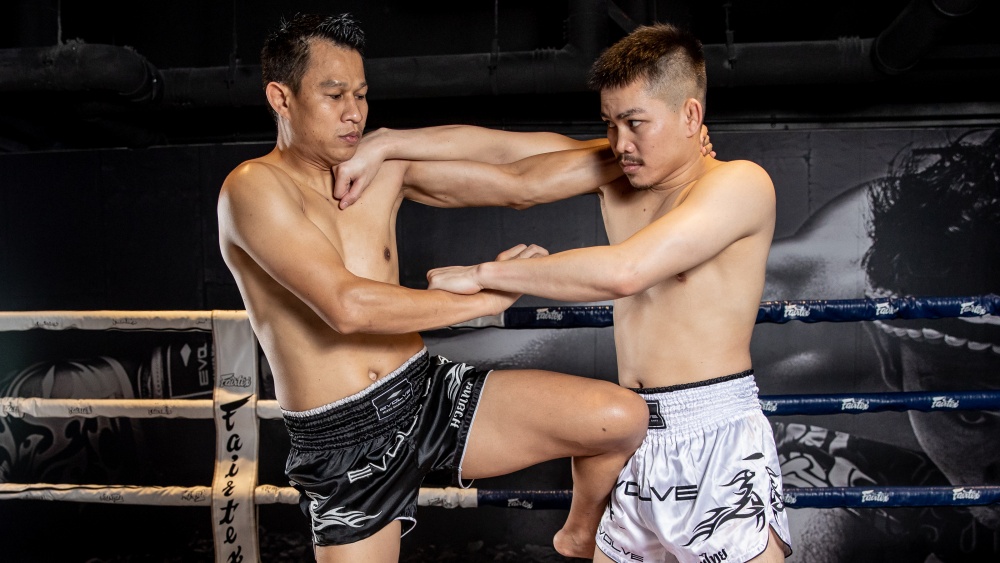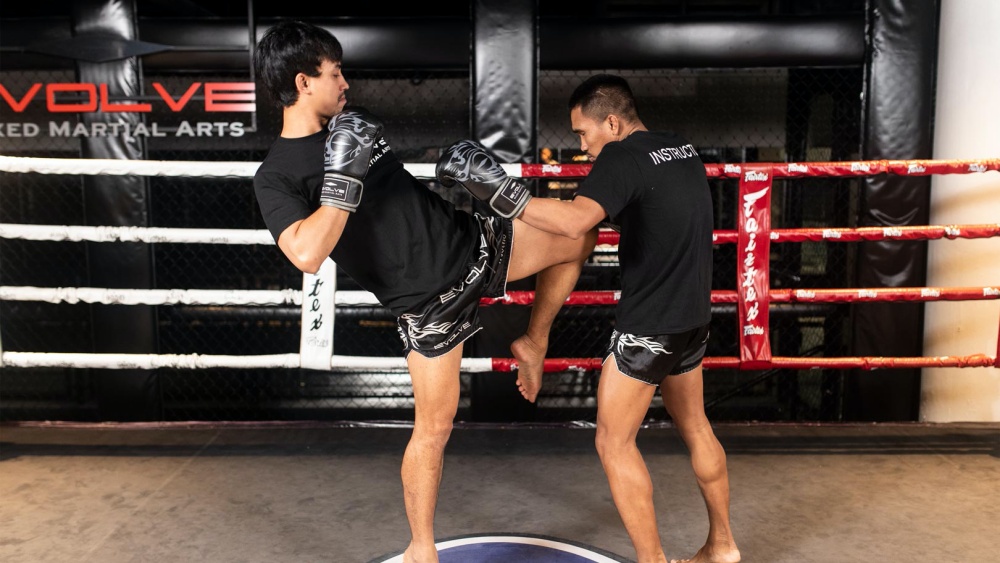The sport of Muay Thai is known as the “Art of Eight Limbs.” Each limb (hands, elbows, knees, and legs) provides unique opportunities for striking and creating dominance over your opponent.
In Muay Thai, knees can be utilized in many different ways, giving opportunities for creating space, powerful strikes, and helping to control your opponent’s posture, especially within the clinch. Even better, the use of your knees means that your hands are free to push, pull, or tie up the clinch on your opponent, as well.
The switch knee leverages footwork (the switch step) to land solid knees on your opponent. Here’s how to utilize the switch knee for your Muay Thai game.
How To Utilize The Switch Knee For Muay Thai
1) Use The Switch Step To Move Your Body Slightly Off-line From Your Opponent
The switch step is a great piece of footwork to move your body away from being straight on with your opponent. This takes you out of the direct line of their strikes, and opens up opportunities for you to utilize your hands to frame off of, or to pull on, the outside shoulder as you drive the knee forward. Here’s how to land this knee.
- While facing your opponent, utilize a switch step to move your body slightly to the right of your opponent.
- Simultaneously drive your rear knee (left knee) forward towards your opponent as you reach your left hand up to frame and pull on their outside shoulder.
- As you land the knee and use your framing hand to help break the opponent’s posture, be sure to utilize the space and the controlled posture to either snatch up a clinch or strike.
- The space you’ve created will leave you with a dominant angle on your opponent and offer you an opportunity to land other strikes as follow-ups.
2) Use The Switch Knee To Cut Distance And Land Strikes Right Up The Middle
If you find yourself straight on with your opponent and have a small amount of distance, a switch knee is a great option for closing some of that distance and landing a knee up the middle on your opponent.
Often, your opponent will not be thinking about you landing a knee since you are just out of range for a regular rear-leg knee, so this is a great option to catch them with a solid strike while they are off guard. Here’s how to land this switch knee.
- While facing your opponent and standing just out of your typical knee range, wait for them to throw and begin retracting a strike towards you.
- As they retract their strike, switch your feet with a forward movement.
- Drive your rear knee forward and straight up the middle at your opponent.
- Utilize your hands to mitigate any strikes your opponent may try to throw at you during the process.
- Be sure to have a slight lean to your upper body as you move in to keep the distance from your head and body to your opponent’s strikes as far away as possible.
3) Use The Switch Knee In The Clinch To Create Movement

The clinch is one of the best places to utilize a switch knee. If you have a solid clinch on your opponent, then you are already controlling their posture. If you want to maintain control of the posture, then it’s pivotal that you continue utilizing movement and knees to keep your opponent on defense and keep them from beginning to work out of the clinch.
Here’s how to use the switch knee to create movement and dominance in the clinch.
- Once you have your opponent in the clinch, switch step your feet.
- Pull your opponent’s head in and down as you drive your knee toward their body.
- After landing the switch knee, plant your foot down behind your lead leg, and use the motion to whip your opponent towards your back leg. This will open up more opportunities for knees, while keeping them off-balance at the same time.
4) Use The Switch Knee To Cut The Distance And Work Towards Elbows
The switch knee is a great way to cut distance, get your body slightly off-line from your opponent, and open the doors for elbows. The switch knee sets up elbows nicely, giving you an opportunity to work in towards dominant strikes on your opponent, while also staying off-line from your opponent. Here’s how to use the switch knee to work into elbows.
- Similarly to example #1, utilize the switch knee to move your body slightly to the right of your opponent.
- Use your left arm to frame and/or pull down on your opponent’s shoulder to begin breaking their posture.
- Land the switch knee to their body as you pull with your framing arm.
- After you land the knee, utilize your positioning, which should be on a slight angle still and also in very close proximity to your opponent, to land the right elbow to your opponent.
- Consider closing into the clinch from this position and continuing with more knees, switching knees, or even elbows.
Muay Thai knees are incredibly dominant strikes all on their own. Add in the footwork of a switch step and you naturally open up many more opportunities for utilizing and landing powerful strikes on your opponent. Whether you are using the switch knee to cut an angle on your opponent, to work into the clinch, to cut distance up the middle, or to work into elbows, you will be sure to find this strike a favorite for your Muay Thai tool bag.
It’s a quick, powerful strike that works in a variety of dynamic ways, making it an important strike to master for all Muay Thai athletes. The next time you hop in the ring to spar or grab a bag to work, consider experimenting with some of these ideas for utilizing the switch knee.
You may also like:
















